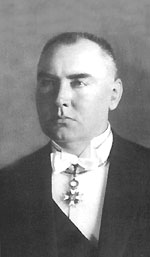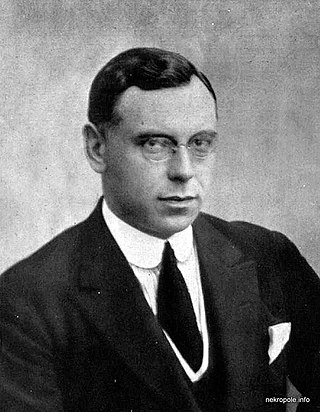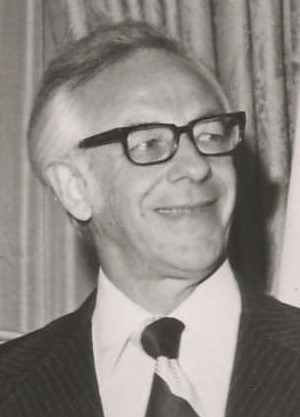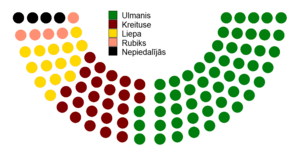
The politics of Latvia takes place in a framework of a parliamentary representative democratic republic, whereby the Prime Minister is the head of government, and of a multi-party system. The President holds a primarily ceremonial role as Head of State. Executive power is exercised by the government. Legislative power is vested in both the government and parliament, the Saeima. The Judiciary is independent of the executive and the legislature. The Economist Intelligence Unit rated Latvia a "flawed democracy" in 2022.

Kārlis Augusts Vilhelms Ulmanis was a Latvian politician. He was one of the most prominent Latvian politicians of pre-World War II Latvia during the Interwar period of independence from November 1918 to June 1940. He served four times as prime minister, the last time as the head of an authoritarian regime, during which he subsequently also adopted the title of President of Latvia. The legacy of his dictatorship continues to divide public opinion in Latvia today.

Guntis Ulmanis, also known as Guntis Rumpītis from 1949 to 1989, is a Latvian politician and the fifth President of Latvia from 1993 to 1999.

Jānis Kristaps Čakste was a Latvian politician and lawyer who served as the first head of an independent Latvian state as the Chairman of the People's Council (1918–1920), the Speaker of the Constitutional Assembly (1920–1922), and as the first President of Latvia (1922–1927).

Alberts Kviesis was a Latvian politician who served as third President of Latvia from 1930 to 1936.

Anatolijs Gorbunovs, also known as Anatoly Valeryanovich Gorbunov, is a Latvian politician who served as the Chairman of the Supreme Soviet during the final years of the Soviet regime in Latvia and as Chairman of the Supreme Council of Latvia during the first years after the country regained its independence.

The Constitution of Latvia is the fundamental law of the Republic of Latvia. Satversme is the oldest Eastern or Central European constitution still in force and the sixth oldest still-functioning republican basic law in the world. It was adopted, as it states itself in the text, by the people of Latvia, as represented in the Constitutional Assembly of Latvia, on 15 February 1922 and came into force on 7 November 1922. It was heavily influenced by Germany's Weimar Constitution and the Swiss Federal Constitution. The constitution establishes the main bodies of government ; it consists of 116 articles arranged in eight chapters.

Zigfrīds Anna Meierovics was a Latvian politician and diplomat who served as the first Foreign Minister of Latvia from its independence until 1924 and again from December of the same year until his death. He also served two terms as the Prime Minister of Latvia from June, 1921 to January, 1923 and from June 1923 to January, 1924. He was one of the founders of the Latvian Farmers' Union, one of Latvia's oldest political parties.

The president of Latvia is head of state and commander-in-chief of the National Armed Forces of the Republic of Latvia.

Alfrēds Rubiks, is a Latvian communist politician and a former leader of the Communist Party of Latvia. He was a Member of the European Parliament for Latvia from 2009 until 2014. In the European Parliament he was a member of the European United Left–Nordic Green Left group.
For a Good Latvia was a Latvian right-wing party alliance founded on 22 April 2010 by the People's Party, Latvia's First Party/Latvian Way, the businessmen's movement For a Good Latvia and some smaller parties. The initial name (AŠ)² referred to the initials of the party leaders of the People's Party and LPP/LC. Both major parties participating had been doing badly in the polls. The alliance was headed by former Latvian president Guntis Ulmanis.

Indirect presidential elections were held in Latvia on 2 June 2011. Incumbent president Valdis Zatlers was standing again, as well as Andris Bērziņš, a former head of SEB Unibanka ; Bērziņš was nominated by five Saeima members of the Union of Greens and Farmers just two days before the nomination deadline, although the party was assumed to back Zatlers for re-election.

Indirect presidential elections were held in Latvia on 29 May 2019.

Indirect presidential elections were held in Latvia on 20 June 2003. The incumbent, Vaira Vīķe-Freiberga, was re-elected by the Saeima to serve a second four-year term with an overwhelming majority.

Courland is one of the five multi-member constituencies of the Saeima, the national legislature of Latvia. The constituency was established in 1922 when the Saeima was established following Latvia's independence from the Soviet Union. It consists of the cities of Liepāja and Ventspils and municipalities of Kuldīga, Saldus, South Kurzeme, Talsi and Ventspils in the region of Courland. The constituency currently elects 12 of the 100 members of the Saeima using the open party-list proportional representation electoral system. At the 2022 parliamentary election it had 180,070 registered electors.

Ilga Kreituse is a Latvian politician, historian, and former Speaker of the Saeima.

The 1922 presidential elections in Latvia took place on November 14, 1922. By agreement between the Latvian Social Democratic Workers' Party and the Latvian Farmers' Union, Jānis Čakste was nominated as the sole candidate and elected the 1st President of Latvia with 92 votes in favor and 6 abstentions. The President was elected by the 1st Saeima.

The 1993 presidential elections in Latvia took place on July 7, 1993. It was the first presidential election after the restoration of Latvia's independence. Guntis Ulmanis was elected the 5th President of Latvia.

Livonia is one of the five multi-member constituencies of the Saeima, the national legislature of Latvia. The constituency was established in 1922 when the Saeima was established following Latvia's independence from the Soviet Union. It consists of the city of Jūrmala and municipalities of Ādaži, Alūksne, Cēsis, Gulbene, Ķekava, Limbaži, Madona, Mārupe, Ogre, Olaine, Ropaži, Salaspils, Saulkrasti, Sigulda, Smiltene, Valka, Valmiera and Varakļāni in the region of Livonia. The constituency currently elects 26 of the 100 members of the Saeima using the open party-list proportional representation electoral system. At the 2022 parliamentary election it had 396,278 registered electors.

Gunārs Meierovics was a Latvian politician and the youngest son of the second Prime Minister of Latvia Zigfrīds Anna Meierovics. Meierovics was also a candidate for the 1993 Latvian presidential election.




















